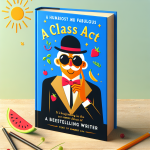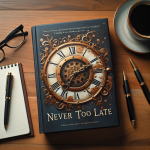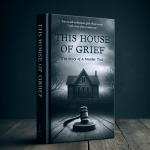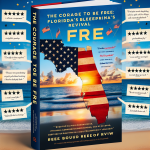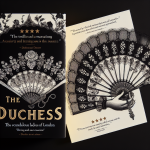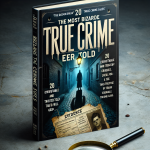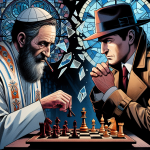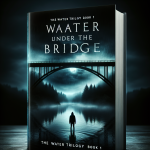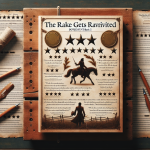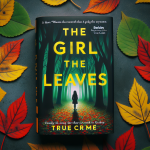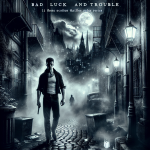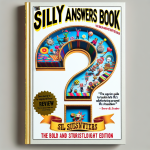As an Amazon Associate I earn from qualifying purchases.
Unveiling Heroism: The Astonishing Journey of Three Teenage Dutch Spies in “Three Ordinary Girls”
Imagine the chaos of Nazi-occupied Netherlands during World War II, where bravery wasn't just admired but desperately needed. In “Three Ordinary Girls: The Remarkable Story of Three Dutch Teenagers Who Became Spies, Saboteurs, Nazi Assassins–and WWII Heroes,” Tim Brady paints an electrifying narrative of courage and defiance. The book follows three young women—Hannie Schaft, and sisters Truus and Freddie Oversteegen—who, despite their youth, took extraordinary risks to fight against the tyranny of the Nazis. Their clandestine activities included espionage, sabotage, and even assassinations, actions that outstripped the expectations of even the bravest adults.
While “Practice to Deceive” delves into an intricate murder investigation, capturing the essence of true crime with its real-life drama and gripping narrative, “Three Ordinary Girls” provides a different kind of thrill. It not only tells a compelling true story, imbued with the fear, tension, and brutality of war but also offers a new perspective on the capabilities of young women in the most harrowing circumstances. This isn't just a book about history; it's a blueprint of heroism and the fight for freedom, showcasing how ordinary individuals can become extraordinary heroes. Within these pages, readers find inspiration and a reminder of the resilience and ingenuity that can emerge even in the darkest times.
body {font-family: Arial, sans-serif; line-height: 1.6; margin: 20px;}
h2 {color: #2c3e50;}
p {margin-bottom: 20px;}
Three Ordinary Girls: The Remarkable Story of Three Dutch Teenagers Who Became Spies, Saboteurs, Nazi Assassins–and WWII Heroes
Plot
The plot of “Three Ordinary Girls” revolves around the lives of three teenage girls: Hannie Schaft, and sisters Truus and Freddie Oversteegen. These young women were initially living ordinary lives in the Netherlands but became extraordinary figures as they joined the Dutch Resistance during World War II. Their mission involved acts of espionage, sabotage, and even assassinations aimed at undermining the Nazi regime. From concealing Jews to executing covert operations against high-ranking Nazi officials, the story captures their courageous and high-stakes endeavors as unsung heroes of the war.
Characters
Hannie Schaft, labeled “the girl with the red hair,” emerges as a central figure whose journey from a law student to a revolutionary is both inspiring and tragic. The Oversteegen sisters, Truus and Freddie, brought in their own set of skills and bravery, rendering a dynamic trio that represented unyielding resistance. These characters are portrayed not just as resistance fighters but as multidimensional individuals grappling with the emotional and ethical challenges of their missions.
Writing Style
The writing style is narrative-driven, supported by meticulously researched facts and interviews. The prose is gripping, combining the tension of a thriller with the factual accuracy of historical documentation. The author employs a balanced approach, ensuring that emotional depth and historical integrity are maintained throughout the narrative. Vivid descriptions and quotes from the girls themselves are employed to lend authenticity and immediacy to the storytelling.
Setting
The setting is primarily the Netherlands during the turbulent years of World War II. From bustling urban centers to hidden countryside hideouts, the backdrop is depicted with great attention to detail. The oppressive atmosphere of Nazi occupation is poignantly conveyed, heightening the stakes for our protagonists who navigate this perilous environment. The setting underscores the gravity of their mission and the constant threat under which they operated.
Unique Aspects
What sets this book apart are the lesser-known yet impactful stories of young women in the resistance, often overshadowed by their male counterparts. The incorporation of personal letters, diary entries, and eyewitness accounts provides an intimate window into their lives. The focus on teenage girls' transition into resistance fighters offers a unique lens on wartime heroism, emphasizing youth, courage, and moral complexity.
Practice to Deceive (A True Crime Bestseller)
True Crime
“Practice to Deceive” delves deep into the world of true crime, exploring the chilling details behind a real-life murder case. The book meticulously unpacks the layers of deceit, manipulation, and psychological intricacies that define the crime. True crime enthusiasts will find the detailed account of the investigation and the legal proceedings particularly engrossing, enhancing their understanding of the complexities involved in solving such heinous acts.
Murder Investigation
The investigation into the murder at the heart of “Practice to Deceive” is thorough and well-documented. The author takes readers through the step-by-step process followed by law enforcement, from the initial crime scene analysis to the eventual apprehension of the suspect. Key investigative techniques such as forensic evidence, witness testimonies, and psychological profiling are examined in detail, providing a comprehensive look at how the case was unraveled.
Real-life Drama
The real-life drama unfolds with all the intensity of a fictional thriller but is grounded in actual events. The interplay between the victim, the murderer, and the myriad people affected by the crime brings a human element to the story. Personal anecdotes, court transcripts, and media reactions are interwoven to create a vivid and dramatic portrayal of the incident and its aftermath.
Gripping Narrative
The gripping narrative style ensures that readers are hooked from the first page. The author employs a mix of narrative techniques such as suspense, cliffhangers, and alternating perspectives to maintain a high level of engagement. Each chapter ends with a compelling hook that propels the story forward, making it difficult for readers to put the book down.
Bestselling Book
Touted as a bestseller, “Practice to Deceive” has captivated a wide audience, evidenced by its position on various bestseller lists. The book’s success can be attributed to its detailed research, engaging storytelling, and the inherent fascination with real-world crimes. Reader reviews and critiques often highlight these aspects, pointing out the meticulous attention to detail and the author's ability to turn complex legal and investigative processes into an accessible and captivating read.
Pros
True Crime Element
The true crime aspect of “Practice to Deceive” creates an immediate connection with readers interested in real-life events. Knowing that the narrative is rooted in actual occurrences can make the story more gripping and engaging. Readers may find the real-life dimensions, including court documents, interviews, and true testimonies, incredibly immersive, adding a layer of realism that fictional crime stories cannot provide. This authenticity can bolster emotional investment and enhance the reading experience.
Murder Investigation Details
The detailed portrayal of murder investigation techniques offers readers an insightful glimpse into the complexities of solving real-life crimes. The comprehensive look at forensic science, legal strategies, and detective work can appeal to those curious about the inner workings of criminal investigations, enriching their understanding of the procedural elements of solving crime. Such detailed exposition not only educates but also enhances the tension and drama of the narrative.
Real-Life Drama
The element of real-life drama in “Practice to Deceive” significantly amplifies the stakes and emotional impact of the story. Readers become more invested in the characters' fates, knowing these were real people with actual losses and triumphs. This connection can make the narrative more moving and impactful, leaving a longer-lasting impression and potentially fostering greater empathy and emotional engagement compared to fictional scenarios.
Gripping Narrative
The gripping narrative style keeps readers on the edge of their seats, eager to turn the next page. Well-crafted suspense and adept pacing maintain high levels of interest and engagement throughout the book. The tension built through skilled storytelling can make for a compelling read, appealing to readers looking for excitement and an emotional roller-coaster. This narrative style effectively hooks readers from the beginning and maintains their interest throughout.
Bestselling Status
Its status as a bestseller signals to potential readers that the book is widely appreciated and well-received. This can serve as an endorsement of quality, encouraging more people to pick up the book with the expectation of a worthwhile read. A bestselling book often indicates a well-crafted story, effective marketing, and strong word-of-mouth recommendations, adding to its appeal and credibility in the highly competitive book market.
Cons
Graphic Content
The inclusion of graphic content, while adding to the realism, may be off-putting or distressing for some readers. Detailed descriptions of violent crimes and autopsy reports can evoke strong emotional reactions, potentially making the book challenging to get through for those sensitive to such content. This aspect can limit the audience, as not all readers are comfortable with explicit details of gruesome events, which can detract from their overall reading experience.
Pace Variability
While the narrative is generally gripping, there can be variability in pacing that might affect reader engagement. Sections dense with technical details or legal jargon can slow down the momentum, causing some readers to lose interest temporarily. Balancing between fast-paced action scenes and slower, informative sections is crucial, and any imbalance can disrupt the flow, making the reading experience inconsistent for those seeking constant excitement.
Sensationalism Concerns
There is a fine line between accurately depicting a true crime story and sensationalizing it for entertainment purposes. Some readers might feel that the book strays towards sensationalism, focusing too much on lurid details rather than respectful and factual recounting of events. This approach can ethical concerns about exploiting real-life tragedies for entertainment, potentially diminishing the book's credibility and the reader's respect for the narrative.
Complexity of Characters
The complexity of characters, deriving from their real-life counterparts, can sometimes make it challenging for readers to fully understand motivations and actions without extensive background information. This can lead to confusion or lack of empathy, as the nuances of someone's life and personality are not always easily conveyed within the confines of a book. Such complexity requires readers to invest more effort in understanding character arcs, impacting ease of reading.
Emotional Toll
The emotional toll of reading about real-life crimes and their impacts on victims' families and communities can be significant. Readers may find it emotionally draining to process the grief, anger, and frustration depicted in the book, which can affect their overall experience. Those looking for escapism in their reading might find the heavy, real-world subject matter too taxing, potentially reducing their enjoyment and satisfaction with the book.
FAQ: Practice to Deceive (A True Crime Bestseller)
What is “Practice to Deceive” about?
“Practice to Deceive” is a true crime book that delves into a complex murder investigation. It explores the real-life drama and psychological intricacies behind a sensational crime, offering a gripping narrative that keeps readers on the edge of their seats.
Why is “Practice to Deceive” considered a bestseller?
The book is considered a bestseller due to its engaging storytelling, thorough research, and compelling portrayal of real-life events. Its popularity among true crime enthusiasts has also contributed to its bestseller status.
Who is the author of “Practice to Deceive”?
The author of “Practice to Deceive” is Ann Rule, a renowned writer known for her extensive work in the true crime genre.
Is “Practice to Deceive” appropriate for all readers?
The book contains mature themes, including detailed descriptions of the crime, murder investigation, and psychological profiles. It may not be suitable for younger readers or those sensitive to such content.
How accurate is the information presented in “Practice to Deceive”?
The author, Ann Rule, is known for her meticulous research and attention to detail. While the book is based on real events and people, some narrative elements may have been dramatized for storytelling purposes. Overall, it provides an accurate portrayal of the case.
Does “Practice to Deceive” include interviews with people involved in the case?
Yes, the book includes interviews with key figures involved in the investigation, providing firsthand insights and perspectives that enhance the authenticity and depth of the narrative.
Can “Practice to Deceive” help in understanding criminal psychology?
Absolutely. The book delves into the psychological motivations behind the crime and profiles of those involved, offering readers a deeper understanding of criminal behavior and investigative techniques.
Is there a movie or TV adaptation of “Practice to Deceive”?
As of the latest information, there is no official movie or TV adaptation of “Practice to Deceive.” However, its compelling story would certainly lend itself well to an adaptation.
Where can I purchase “Practice to Deceive”?
Practice to Deceive” is available for purchase at major bookstores, online retailers like Amazon, and possibly in local libraries. It is also available in various formats including hardcover, paperback, and eBook.
In conclusion, “Three Ordinary Girls: The Remarkable Story of Three Dutch Teenagers Who Became Spies, Saboteurs, Nazi Assassins–and WWII Heroes” stands as a luminous addition to the genre of true crime and historical literature. This incredible narrative not only provides a penetrating look into one of history’s darkest times but also underscores the relentless bravery and tenacity of the human spirit. The real-life drama encapsulated in the lives of these three young women paints a picture that is both harrowing and inspiring, making it an indispensable read for enthusiasts of gripping historical accounts and true crime sagas.
Reading “Three Ordinary Girls” is more than just a literary experience; it is an immersive journey into the lives of Hannie Schaft, Truus Oversteegen, and Freddie Oversteegen, whose tales of espionage, resistance, and sheer determination against the oppressive Nazi regime serve as a potent reminder of the profound impact individuals can make, even in the face of seemingly insurmountable odds. The book delves deeply into their covert operations, personal sacrifices, and the emotional and psychological landscapes they navigated, bringing to life the palpable tension and relentless danger they confronted daily.
Moreover, the narrative structure and vivid storytelling presented by the author ensure that readers are not merely passive recipients of historical facts but are actively engaged, feeling every pulse of anxiety, every moment of clandestine victory, and every smattering of hope that drove these heroines. The meticulously researched backdrop of World War II further augments the book’s authenticity, making it a valuable educational resource as well.
Choosing “Three Ordinary Girls” offers readers a gripping narrative that transcends typical historical recounting. It serves as a profound reminder of the extraordinary feats that can be achieved through courage and unity. The insights and benefits readers gain are manifold—ranging from a deeper understanding of wartime dynamics to an appreciation for the unyielding resolve these young women exhibited.
For anyone with an interest in true crime, historical bravery, and real-life drama, this bestselling book is not just a worthwhile addition to your collection; it is a must-read that promises to leave an indelible mark on your understanding of history and the power of the human spirit.
Amazon and the Amazon logo are trademarks of Amazon.com, Inc, or its affiliates.










